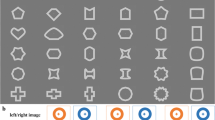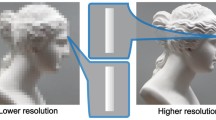Abstract
Humans use binocular disparity to extract depth information from two-dimensional retinal images in a process called stereopsis. Previous studies usually introduce the standard univariate analysis to describe the correlation between disparity level and brain activity within a given brain region based on functional magnetic resonance imaging (fMRI) data. Recently, multivariate pattern analysis has been developed to extract activity patterns across multiple voxels for deciphering categories of binocular disparity. However, the functional connectivity (FC) of patterns based on regions of interest or voxels and their mapping onto disparity category perception remain unknown. The present study extracted functional connectivity patterns for three disparity conditions (crossed disparity, uncrossed disparity, and zero disparity) at distinct spatial scales to decode the binocular disparity. Results of 27 subjects’ fMRI data demonstrate that FC features are more discriminatory than traditional voxel activity features in binocular disparity classification. The average binary classification of the whole brain and visual areas are respectively 87% and 79% at single subject level, and thus above the chance level (50%). Our research highlights the importance of exploring functional connectivity patterns to achieve a novel understanding of 3D image processing.







Similar content being viewed by others
References
Abraham A et al (2014) Machine learning for neuroimaging with scikit-learn. Front Neuroinform 8:14
Allen EA et al (2014) Tracking whole-brain connectivity dynamics in the resting state. Cereb Cortex 24:663–676
Anzai A et al (2011) Coding of stereoscopic depth information in visual areas V3 and V3A. J Neurosci 31:10270–10282
Backus BT et al (2001) Human cortical activity correlates with stereoscopic depth perception. J Neurophysiol 86:2054–2068
Baczkowski BM et al (2017) Sliding-window analysis tracks fluctuations in amygdala functional connectivity associated with physiological arousal and vigilance during fear conditioning. NeuroImage 153:168–178
Barlow HB, Blakemore C, Pettigrew JD (1967) The neural mechanism of binocular depth discrimination. J Physiol 193:327–342
Betzel RF et al (2017) Multi-scale brain networks. NeuroImage 160:73–83
Breiman L (2001) Random forests. Mach Learn 45:5–32
Breiman L (2017) Classification and regression trees. Routledge
Bridge H et al (2007) Topographical representation of binocular depth in the human visual cortex using fMRI. J Vis 7(15):1–14
Chao-Gan Y et al (2016) DPABI: data processing & analysis for (resting-state) brain imaging. Neuroinformatics 14:339–351
Dasdemir Y et al (2017) Analysis of functional brain connections for positive–negative emotions using phase locking value. Cogn Neurodyn 11:487–500
DeAngelis GC et al (1998) Cortical area MT and the perception of stereoscopic depth. Nature 394:677
Deli E et al (2017) Relationships between short and fast brain timescales. Cogn Neurodyn 11:539–552
Fang Y et al (2018) Semantic representation in the white matter pathway. PLoS Biol 16:e2003993
Feinberg DA et al (2010) Multiplexed echo planar imaging for sub-second whole brain FMRI and fast diffusion imaging. PLoS ONE 5:e15710
Fields C et al (2017) Disrupted development and imbalanced function in the global neuronal workspace: a positive-feedback mechanism for the emergence of ASD in early infancy. Cogn Neurodyn 11:1–21
Finlayson NJ et al (2017) Differential patterns of 2D location versus depth decoding along the visual hierarchy. NeuroImage 147:507–516
Friston KJ et al (1995) Analysis of fMRI time-series revisited. NeuroImage 2:45–53
Goncalves NR et al (2015) 7 Tesla FMRI reveals systematic functional organization for binocular disparity in dorsal visual cortex. J Neurosci 35:3056–3072
Gonzalez-Castillo J et al (2015) Tracking ongoing cognition in individuals using brief, whole-brain functional connectivity patterns. Proc Natl Acad Sci 112:8762–8767
Haxby JV (2012) Multivariate pattern analysis of fMRI: the early beginnings. NeuroImage 62:852–855
Haxby JV, Gobbini MI, Furey ML, Ishai A, Schouten JL, Pietrini P (2001) Distributed and overlapping representations of faces and objects in ventral temporal cortex. Science 293:2425–2430
Haxby JV et al (2014) Decoding neural representational spaces using multivariate pattern analysis. Annu Rev Neurosci 37:435–456
Hubel DH et al (2015) Binocular stereoscopy in visual areas V-2, V-3, and V-3A of the macaque monkey. Cereb Cortex 25:959–971
Hutchison RM et al (2014) Distinct and distributed functional connectivity patterns across cortex reflect the domain-specific constraints of object, face, scene, body, and tool category-selective modules in the ventral visual pathway. NeuroImage 96:216–236
Kourtzi Z et al (2000) Cortical regions involved in perceiving object shape. J Neurosci 20:3310–3318
Krug K et al (2011) Neurons in dorsal visual area V5/MT signal relative disparity. J Neurosci 31:17892–17904
Lambooij M et al (2009) Visual discomfort and visual fatigue of stereoscopic displays: a review. J Imaging Sci Technol 53:30201-1–30201-14
Langs G et al (2011) Detecting stable distributed patterns of brain activation using gini contrast. NeuroImage 56:497–507
Li Y et al (2017) Stereoscopic processing of crossed and uncrossed disparities in the human visual cortex. BMC Neurosci 18:80
Liu C et al (2018) Image categorization from functional magnetic resonance imaging using functional connectivity. J Neurosci Meth 309:71–80
Minini L et al (2010) Neural modulation by binocular disparity greatest in human dorsal visual stream. J Neurophysiol 104:169–178
Mizraji E et al (2017) The feeling of understanding: an exploration with neural models. Cogn Neurodyn 11:135–146
Naselaris T et al (2011) Encoding and decoding in fMRI. NeuroImage 56:400–410
Neri P et al (2004) Stereoscopic processing of absolute and relative disparity in human visual cortex. J Neurophysiol 92:1880–1891
Nienborg H et al (2006) Macaque V2 neurons, but not V1 neurons, show choice-related activity. J Neurosci 26:9567–9578
Norman KA et al (2006) Beyond mind-reading: multi-voxel pattern analysis of fMRI data. Trends Cogn Sci 10:424–430
Pantazatos SP et al (2012) Decoding unattended fearful faces with whole-brain correlations: an approach to identify condition-dependent large-scale functional connectivity. PLoS Comput Biol 8:e1002441
Parhizi B et al (2018) Decoding the different states of visual attention using functional and effective connectivity features in fMRI data. Cogn Neurodyn 12:157–170
Preston TJ et al (2008) Multivoxel pattern selectivity for perceptually relevant binocular disparities in the human brain. J Neurosci 28:11315–11327
Richiardi J et al (2011) Decoding brain states from fMRI connectivity graphs. NeuroImage 56:616–626
Shirer WR et al (2012) Decoding subject-driven cognitive states with whole-brain connectivity patterns. Cereb Cortex 22:158–165
Smith SM et al (2011) Network modelling methods for FMRI. NeuroImage 54:875–891
Stevens WD et al (2015) Functional connectivity constrains the category-related organization of human ventral occipitotemporal cortex. Hum Brain Mapp 36:2187–2206
Tagliazucchi E et al (2012) Automatic sleep staging using fMRI functional connectivity data. NeuroImage 63:63–72
Tozzi A et al (2017) From abstract topology to real thermodynamic brain activity. Cogn Neurodyn 11:283–292
Wang X et al (2016) Representing object categories by connections: evidence from a mutivariate connectivity pattern classification approach. Hum Brain Mapp 37:3685–3697
Yamashita O et al (2008) Sparse estimation automatically selects voxels relevant for the decoding of fMRI activity patterns. NeuroImage 42:1414–1429
Yan SM (1985) Digital stereoscopic test charts. People’s Medical Publishing House
Yang Z et al (2014) Common intrinsic connectivity states among posteromedial cortex subdivisions: insights from analysis of temporal dynamics. NeuroImage 93(Pt 1):124–137
Acknowledgements
This work of this paper is funded by the National Key Technologies R&D program (2017YFB1002502), and the project of Beijing Advanced Education Center for Future Education (BJAICFE2016IR-003).
Author information
Authors and Affiliations
Corresponding author
Additional information
Publisher's Note
Springer Nature remains neutral with regard to jurisdictional claims in published maps and institutional affiliations.
Rights and permissions
About this article
Cite this article
Liu, C., Li, Y., Song, S. et al. Decoding disparity categories in 3-dimensional images from fMRI data using functional connectivity patterns. Cogn Neurodyn 14, 169–179 (2020). https://doi.org/10.1007/s11571-019-09557-6
Received:
Revised:
Accepted:
Published:
Issue Date:
DOI: https://doi.org/10.1007/s11571-019-09557-6




